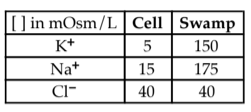The renal corpuscle consists of the __________.
renal pelvis and renal papillae
major calyx and minor calyces
glomerulus and glomerular capsule
proximal and distal convoluted tubules
glomerulus and glomerular capsule
You might also like to view...
For fun, you have used new molecular biology techniques to insert protein channels into the cell membrane that allow only Na+ and Cl- to pass. Predict which ion(s) will move. Tell what direction it (they) will move and what force(s) is/are acting on it (them).
We have finally discovered life on Venus. NASA scientists are investigating a newly discovered life form: a single-celled organism found in the swampy canals. You have been contracted by NASA to perform an electrophysiology study. Using intracellular electrodes to measure the electrical charge inside the cell, you find it has a resting membrane potential of -45 mV when the outside fluid is arbitrarily set to 0 mV. Additionally, you have determined ion concentrations and listed them below.

The attachment of a muscle to a bone is called
A) a tendon. B) a ligament. C) an aponeurosis. D) a capsule. E) either a tendon or an aponeurosis.
The enteric plexus
A. controls movement and secretion of the digestive tract. B. is found in the mucosa. C. contains sympathetic neurons and fibers. D. consists of the myenteric plexus and the celiac plexus. E. is a valve in the GI tract.
The anatomical name for the tailbone is the
A. coccyx. B. ilium. C. sacrum. D. atlas.